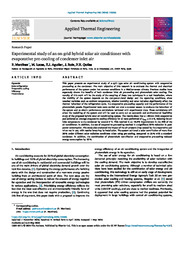Por favor, use este identificador para citar o enlazar este ítem:
https://hdl.handle.net/11000/35398Registro completo de metadatos
| Campo DC | Valor | Lengua/Idioma |
|---|---|---|
| dc.contributor.author | Martínez, Pedro Juan | - |
| dc.contributor.author | Lucas Miralles, Manuel | - |
| dc.contributor.author | Aguilar-Valero, Francisco Javier | - |
| dc.contributor.author | Ruiz Ramírez, Javier | - |
| dc.contributor.author | Vicente-Quiles, Pedro | - |
| dc.contributor.other | Departamentos de la UMH::Ingeniería Mecánica y Energía | es_ES |
| dc.date.accessioned | 2025-01-28T13:42:47Z | - |
| dc.date.available | 2025-01-28T13:42:47Z | - |
| dc.date.created | 2024 | - |
| dc.identifier.citation | Applied Thermal Engineering | es_ES |
| dc.identifier.issn | 1873-5606 | - |
| dc.identifier.issn | 1359-4311 | - |
| dc.identifier.uri | https://hdl.handle.net/11000/35398 | - |
| dc.description.abstract | This paper presents an experimental study of a split type solar air conditioning system with evaporative pre-cooling at the condenser. The main objective of this research is to evaluate the thermal and electrical performance of the system under hot summer conditions in a Mediterranean climate. Previous studies have separately shown the benefits of both condenser inlet air pre-cooling and photovoltaic solar cooling. The novelty of this work will be the study of the coupling of these two techniques in a real installation, where the viability of the system depends on the component-level design and the operating conditions, since weather variables such as ambient temperature, relative humidity and solar radiation significantly affect the thermal behaviour of the refrigeration cycle, the evaporative pre-cooling capacity and the performance of the photovoltaic panels. Experimental tests were carried out over a summer season to evaluate the behaviour of the system and to obtain performance correlations validated with experimental data. These correlations will allow the modelling of the system and will be used to carry out an economic and environmental feasibility study of the proposed hybrid solar air conditioning system. The results show that a 100 mm-thick evaporative pad achieved an average evaporative cooling efficiency for all tests performed of ɛ , reducing the air inlet temperature to the condenser by around 6 °C. This resulted in an 18.3 % improvement in the of the air conditioner. In addition, the use of evaporative pre-cooling resulted in a significant 23 % reduction in peak power consumption. The study also evaluated the impact of the air pressure drop caused by the evaporative pad when not in use, with results favouring its installation. The system achieved a solar contribution of more than 30 % under different solar radiation conditions when using pre-cooling, compared to 25 % with a standard condenser. In addition, the combination of photovoltaic contribution and evaporative pre-cooling reduced energy consumption by 43 %. | es_ES |
| dc.format | application/pdf | es_ES |
| dc.format.extent | 19 | es_ES |
| dc.language.iso | eng | es_ES |
| dc.publisher | Elsevier | es_ES |
| dc.relation.ispartofseries | 248 | es_ES |
| dc.relation.ispartofseries | B | es_ES |
| dc.rights | info:eu-repo/semantics/openAccess | es_ES |
| dc.rights | Attribution-NonCommercial-NoDerivatives 4.0 Internacional | * |
| dc.rights.uri | http://creativecommons.org/licenses/by-nc-nd/4.0/ | * |
| dc.subject | Solar refrigeration | es_ES |
| dc.subject | Evaporative cooling | es_ES |
| dc.subject | Efficiency | es_ES |
| dc.subject | Photovoltaics | es_ES |
| dc.subject.other | CDU::6 - Ciencias aplicadas::62 - Ingeniería. Tecnología::621 - Ingeniería mecánica en general. Tecnología nuclear. Electrotecnia. Maquinaria | es_ES |
| dc.title | Experimental study of an on-grid hybrid solar air conditioner with evaporative pre-cooling of condenser inlet air | es_ES |
| dc.type | info:eu-repo/semantics/article | es_ES |
| dc.relation.publisherversion | https://doi.org/10.1016/j.applthermaleng.2024.123335 | es_ES |

Ver/Abrir:
2024 ATE 248.pdf
4,53 MB
Adobe PDF
Compartir:
 La licencia se describe como: Atribución-NonComercial-NoDerivada 4.0 Internacional.
La licencia se describe como: Atribución-NonComercial-NoDerivada 4.0 Internacional.
.png)